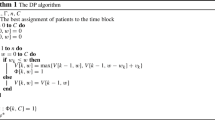Abstract
Effective admission planning can improve inpatient throughput and waiting times, resulting in better quality of service. The uncertainty in the patient arrival and the availability of resources makes the patient’s allocation difficult to manage. Thus, in the admission process hospitals aim to accomplish targets of resource utilization and to lower the cost of service. Both objectives are related and in conflict. In this paper, we present a bi-objective stochastic optimization model to study the trade-off between the resource utilization and the cost of service, taking into account demand and capacity uncertainties. Real data from the surgery and medical areas of a Chilean public hospital are used to illustrate the approach. The results show that the solutions of our approach outperform the actual practice in the Chilean hospital.







Similar content being viewed by others
References
Adan I, Bekkers J, Dellaert N, Jeunet J, Vissers J (2011) Improving operational effectiveness of tactical master plans for emergency and elective patients under stochastic demand and capacitated resources. Eur J Oper Res 213(1):290–308
Adan I, Bekkers J, Dellaert N, Vissers J, Yu X (2009) Patient mix optimisation and stochastic resource requirements: a case study in cardiothoracic surgery planning. Health Care Management Science 12(2):129
Alvarez PP, Vera JR (2014) Application of robust optimization to the sawmill planning problem. Ann Oper Res 219(1):457–475
Bekker R, Koeleman PM (2011) Scheduling admissions and reducing variability in bed demand. Health Care Management Science 14(3):237
Birge JR, Louveaux F (2011) Introduction to stochastic programming. Springer Science & Business Media, Berlin
Conejo AJ, Carrión M, Morales JM, et al. (2010) Decision making under uncertainty in electricity markets, vol 1. Springer, Berlin
Deb K (2014) Multi-objective optimization. Search methodologies. Springer, New York, pp 403–49
Dobson G, Lee H-H, Pinker E (2010) A model of icu bumping. Operations Research 58(6):1564–1576
Durán G., Rey PA, Wolff P (2017) Solving the operating room scheduling problem with prioritized lists of patients. Ann Oper Res 258(2):395–414
Gallivan S, Utley M, Treasure T, Valencia O (2002) Booked inpatient admissions and hospital capacity: mathematical modelling study. Bmj 324(7332):280–282
Gemmel P, Van Dierdonck R (1999) Admission scheduling in acute care hospitals: does the practice fit with the theory? International Journal of Operations & Production Management 19(9):863–878
Green LV (2002) How many hospital beds? Inquiry: the Journal of Health Care Organization, Provision, and Financing 39(4):400–412
Green LV (2005) Capacity planning and management in hospitals. In: Operations research and health care. Springer. pp 15–41
Guerriero F, Guido R (2011) Operational research in the management of the operating theatre: a survey. Health Care Management Science 14(1):89–114
Helm JE, AhmadBeygi S, Van Oyen MP (2011) Design and analysis of hospital admission control for operational effectiveness. Prod Oper Manag 20(3):359–374
Hulshof PJ, Boucherie RJ, Hans EW, Hurink JL (2013) Tactical resource allocation and elective patient admission planning in care processes. Health Care Management Science 16(2):152–166
Hulshof PJ, Mes MR, Boucherie RJ, Hans EW (2016) Patient admission planning using approximate dynamic programming. Flex Serv Manuf J 28(1–2):30–61
Kortbeek N, Braaksma A, Burger CA, Bakker PJ, Boucherie RJ (2015) Flexible nurse staffing based on hourly bed census predictions. Int J Prod Econ 161:167–180
Kusters RJ, Groot PM (1996) Modelling resource availability in general hospitals design and implementation of a decision support model. Eur J Oper Res 88(3):428–445
Lamiri M, Xie X, Dolgui A, Grimaud F (2008) A stochastic model for operating room planning with elective and emergency demand for surgery. Eur J Oper Res 185(3):1026–1037
Min D, Yih Y (2010) An elective surgery scheduling problem considering patient priority. Comput Oper Res 37(6):1091–1099
Mullen PM (2003) Prioritising waiting lists: how and why? Eur J Oper Res 150(1):32–45
Peters-Groot P (1993) Decision support for admission planning under multiple resource constraints. PhD thesis. Technische Universiteit Eindhoven
Pozo D, Sauma EE, Contreras J (2013) A three-level static milp model for generation and transmission expansion planning. IEEE Transactions on Power Systems 28(1):202–210
Samudra M, Van Riet C, Demeulemeester E, Cardoen B, Vansteenkiste N, Rademakers FE (2016) Scheduling operating rooms: achievements, challenges and pitfalls. J Sched 19(5): 493–525
Tamiz M, Mirrazavi S, Jones D (1999) Extensions of pareto efficiency analysis to integer goal programming. Omega 27(2): 179–188
Testi A, Tànfani E (2009) Tactical and operational decisions for operating room planning: efficiency and welfare implications. Health Care Management Science 12(4):363
Testi A, Tanfani E, Valente R, Ansaldo G, Torre G (2008) Prioritizing surgical waiting lists. J Eval Clin Pract 14(1):59–64
Thompson S, Nunez M, Garfinkel R, Dean MD (2009) Or practice—efficient short-term allocation and reallocation of patients to floors of a hospital during demand surges. Operations Research 57(2):261–273
Vissers J, Adan IJ, Bekkers JA (2005) Patient mix optimization in tactical cardiothoracic surgery planning: a case study. IMA J Manag Math 16(3):281–304
Vissers JM, Adan IJ, Dellaert NP (2007) Developing a platform for comparison of hospital admission systems: an illustration. Eur J Oper Res 180(3):1290–1301
Acknowledgements
This research was supported by CONICYT under Grant 6635/2014 and FONDEF project CA13I10319. Author J. Vera would like to acknowledge the support of Iniciativa Milenio grant ICM/FIC RC130003. The authors would like to thank the collaboration of the managers of the Chilean Hospital used in this research as they provide data and insights used to solve the problem presented in this paper.
Author information
Authors and Affiliations
Corresponding author
Additional information
Publisher’s note
Springer Nature remains neutral with regard to jurisdictional claims in published maps and institutional affiliations.
Appendix: Result tables
Appendix: Result tables
Tables 6 and 7, show the values of the patient allocation related to Internal, External, Temporary assignment and Unmet demand as well, according to the weight, λ.
Rights and permissions
About this article
Cite this article
Batista, A., Vera, J. & Pozo, D. Multi-objective admission planning problem: a two-stage stochastic approach. Health Care Manag Sci 23, 51–65 (2020). https://doi.org/10.1007/s10729-018-9464-4
Received:
Accepted:
Published:
Issue Date:
DOI: https://doi.org/10.1007/s10729-018-9464-4




